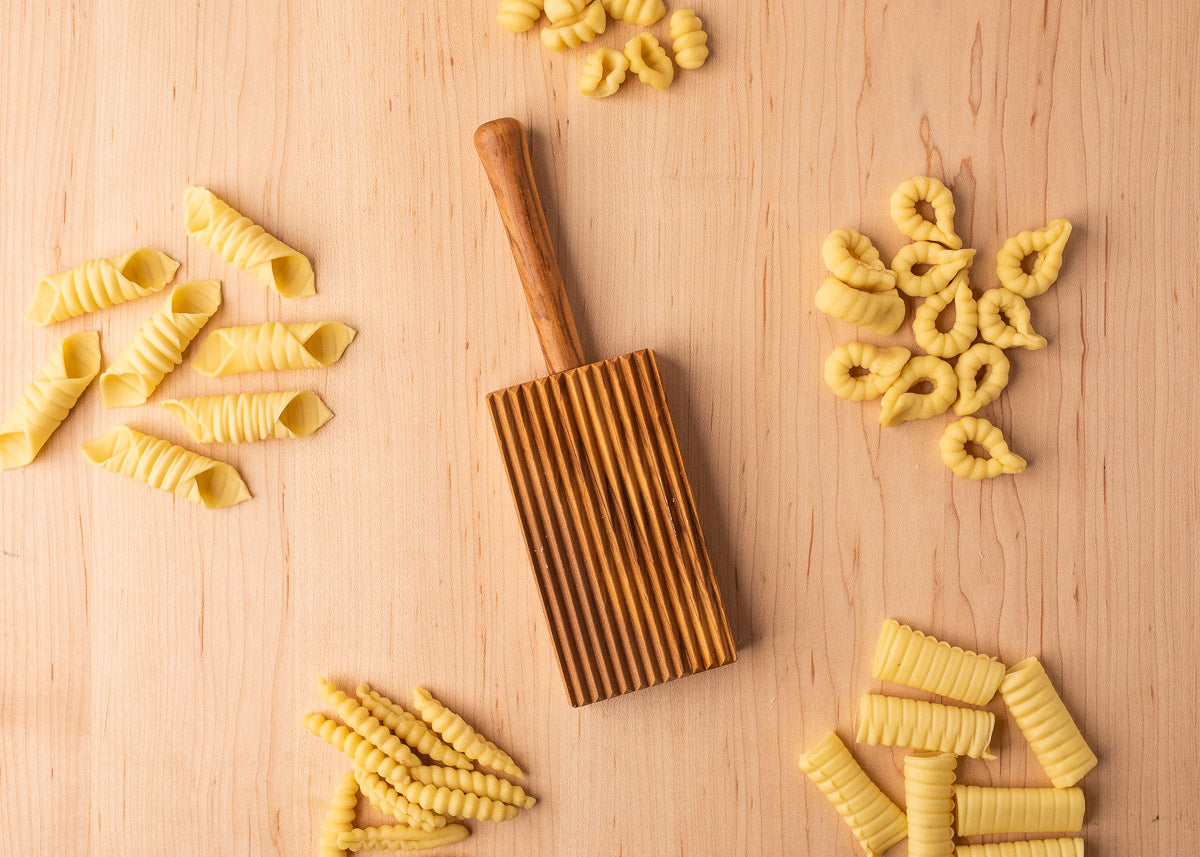
Five Pasta Shapes You Can Make with a Gnocchi Board
|
|
Time to read 4 min
FREE U.S. SHIPPING 11/25-12/1. No code required.
|
|
Time to read 4 min
Don’t be fooled by its name: gnocchi boards aren’t just for gnocchi! In fact, a gnocchi board is arguably one of the most versatile pasta tools you can have in your kitchen. With one small and relatively inexpensive tool, you can make a variety of pasta shapes.
A gnocchi board is a small, rectangular board, usually made of wood, with a ridged surface. The grooves on the board imprint a lined surface on pasta dough, which helps to capture sauce and provides an interesting texture. Some gnocchi boards also come with wooden dowels, which are used to create tube-shaped pastas.
We’ve listed the gnocchi board as one of our most essential pasta tools because it can make so many different types of pasta! It’s also a great pasta tool for beginners since they aren’t that expensive and they’re easy to use.
Gnocchi Board Pasta Shapes: Table of Contents
This small rectangular board is used to create sauce-capturing ridges on not only gnocchi but also several other types of pasta. Below is five gnocchi board pasta shapes you can make with this simple tool!
Also known as gnocchetti sardi or malloreddus, Sardinian gnocchi are small ridged shells. They look similar to gnocchi, but the dough is made of semola flour and water instead of potato. They are typically served with rich meat sauces, and sometimes in Sardinia, they are infused with saffron.
To make Sardinian gnocchi, roll your semolina pasta dough into a long rope, about 1/2-inch thick. Cut the rope into 1/2-inch pieces. Take one pillow of dough and place it on the gnocchi board. Press your thumb or index finger into the center and roll the dough across the board, creating a hollow center and a ridged surface on the opposing side.
A typical pasta shape of Southern Italy, cavatelli are widespread, beloved by many for their ridged texture and bite-sized, shell shape. They’re also quick and easy to prepare, making it a great shape for beginner pasta makers. They can vary in size and length across different regions in Italy. For example, in Calabria, cavatelli are made with only one index finger and look more like Sardinian Gnocchi. In regions such as Puglia and Molise, they are made longer, using 2-3 fingers to roll the dough across the board.
To make cavatelli, roll your semolina pasta dough into a long rope, about 1/2-inch thick. Cut the rope into 1/2-inch to 1.5-inch pieces. Using a finger (or fingers for longer pieces of dough) or a bench scraper, roll the piece of dough across the board to create a hollow center and a ridged surface.
Spizzulus is a unique, lesser-known pasta shape that hails from Sardinia. The name comes from the Sardinian dialect for “pinch,” as they are sealed by pressing the two ends of the dough together. This traditional pasta is often enjoyed during special occasions and festive meals in Sardinia.
To make spizzulus, roll your semolina pasta dough into a long rope, about 1/4-inch thick. Cut the rope into 7 cm pieces. Use a bench scraper to roll the piece of dough across the board to form ridges. Using your thumb and index finger, press the two ends of the rope together to form a ring.
Rigatoni, a staple of Italian cuisine, is a large, ridged, tube-shaped pasta that is usually made with an extruder. The name "rigatoni" comes from the Italian word "rigare," meaning "to draw a line," referring to the ridges on the pasta that help hold onto sauces. Rigatoni is popular throughout Italy, particularly in the central and southern regions.
Although rigatoni is usually made with an extruder, you can also try your hand at making them at home. After your pasta dough has rested, cut off a 100-gram piece of dough and roll it through your pasta machine until it is the thickness of a dime (setting 6 on a Marcato Atlas 150 pasta machine). Cut the sheet of dough into 1 1/2-inch squares. Wrap the square around a wooden pasta dowel, sealing two sides together. Gently roll it over your board to create ridges. Slide the tube off the dowel.
Garganelli is a traditional pasta from the Emilia-Romagna region of Italy. It is similar to rigatoni but with a distinctive diagonally rolled shape. The name "garganelli" comes from the dialect word "garganel," meaning "chicken gullet," due to the pasta’s resemblance to the esophagus of a chicken. Garganelli is often served with rich, hearty sauces or in broths.
The process for making garganelli is similar to rigatoni, except you will wrap the square of dough around the dowel diagonally. After your pasta dough has rested, cut off a 100-gram piece of dough and roll it through your pasta machine until it is the thickness of a dime (setting 6 on a Marcato Atlas 150 pasta machine). Cut the sheet of dough into 1 1/2-inch squares. Wrap the square around a wooden pasta dowel diagonally, sealing two opposite corners together. Gently roll it over your board to create ridges. Slide the tube off the dowel.
The gnocchi board is a deceptively simple yet incredibly versatile tool that can transform your pasta-making experience. From traditional Sardinian gnocchi to unique shapes like spizzulus, rigatoni, and garganelli, this tool opens up a world of culinary possibilities. Whether you are a beginner or an experienced pasta maker, a gnocchi board is a valuable addition to your kitchen arsenal, helping you create delicious and visually appealing pasta dishes that capture and hold sauce beautifully.
If you’re looking for more pasta-making tips and recipes, explore our other articles or check out our recommended pasta tools. Embrace the versatility of the gnocchi board and elevate your pasta-making skills to new heights.